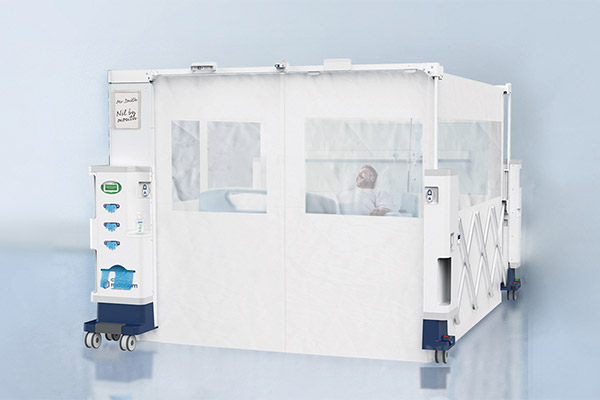RediRoom a help for hospitals
This is the story of an Avondale nursing alumna with an eponymous last name, her entrepreneurial brother-in-law and a greeting at graduation with a professor whose research has helped bring a hospital infection control resource to market.
The story begins when Esther Nurse graduated from the Bachelor of Nursing course in 2014. Over graduation weekend, she introduced one of her lecturers to sister and brother-in-law Anna and Justin Ballantyne. With friend and industrial designer James Burkwood, they had been working on an idea called RediRoom, a temporary single-patient isolation room to help hospitals reduce the spread of infection. The lecturer? Professor Brett Mitchell, an infection control specialist. “The lack of single rooms in hospitals is a problem here in Australia and overseas,” he says. “I immediately saw in RediRoom a potential solution.”
Justin had already secured patents. He, Burkwood and Mitchell then procured a government grant that enabled construction of a “rudimentary” but workable prototype. The prototype represented everything RediRoom is today, with some improvements added based on feedback from clinicians. Mitchell also introduced Justin to GAMA Healthcare, which is now a commercial partner.
In testing, Justin and Mitchell examined RediRoom’s functionality, “in particular, whether clinical procedures could still be undertaken as normal,” notes Mitchell. “We also explored the infection control specifications and suitability,” he adds. “In both instances, the room performed positively.” Mitchell’s research helped the Ballantynes and manufacturer CareStrategic make further improvements.
RediRoom “will have a positive impact on the prevention and control of infections and pathogen transfer in hospitals,” says Mitchell. Which is just as well because its origins lie in Justin seeking a solution for a problem his wife faced.
An accident and emergency nurse, “Anna kept coming home frustrated, saying, ‘I can’t move my infectious patients out of emergency. There are never any single rooms available!’” The majority of patients who needed to be isolated fell under contact and droplet precautions, so staff would usually just pin a sign on the “magic curtains” as Anna nicknamed them. She read international, national and state guidelines “and kept saying, ‘All we need to do is put up a tent.’ I listened to her complaints for about a year, then I said, ‘That’s it. I’m finding a solution!’”.
The Ballantynes went looking to see if one existed. It did and didn’t. Others were also trying to find a solution but “everything was slow, impractical and expensive,” notes Justin. The more they searched, the more they discovered the extent of the problem. “We decided to simply create something for Anna and her hospital in the hope it would also help solve such a big issue globally.”
RediRoom is now in the final stages of production. Plans are to trial it in five hospitals in Australia and another five in the United Kingdom. “It’ll be on the market by this time next year,” says Justin. Potential customers, having seen RediRoom at several infection control conferences, are eagerly waiting. “All of the responses have been similar. People are saying, ‘This is fantastic! When can we have it?’”
What will creating a product that helps lift the burden of preventing healthcare-associated infections feel like? “A job well done,” says Justin.
Reflections
This article also appears in the Summer 2018 issue of Reflections, the magazine for alumni and friends of Avondale College of Higher Education. Read Reflections on Issuu.
READ: REFLECTIONS ON ISSUUShare

